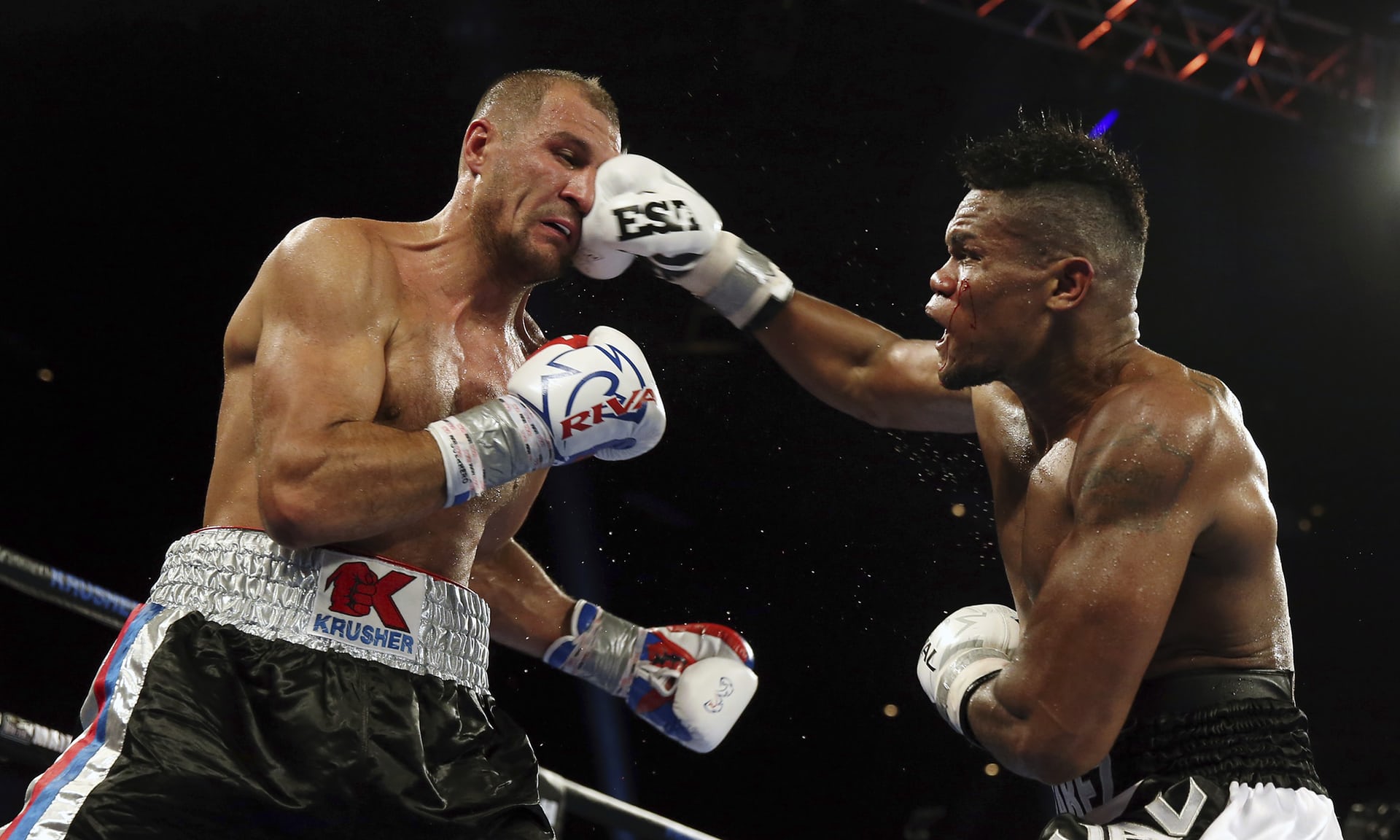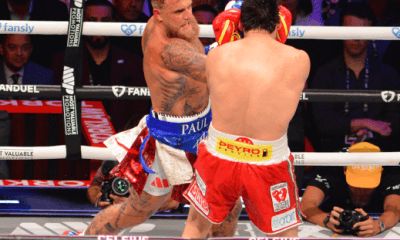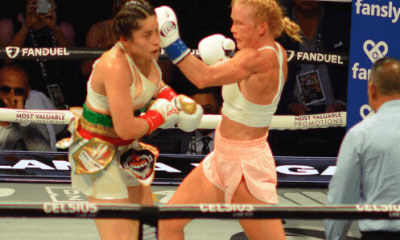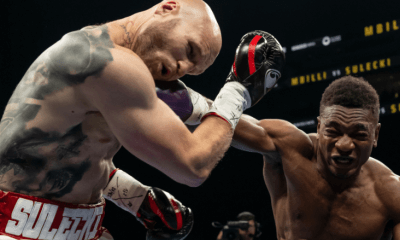Featured Articles
Three Punch Combo: Digging Deeper Into the Alvarez-Kovalev Upset and More

THREE PUNCH COMBO — My background is in economics. When studying economics, we often look to the past to attempt to predict future outcomes. For example, when the last recession occurred we compile what the data said prior to the start of that recession and look for future similarities to predict when the economy may be headed toward another downturn. This is all done after the fact with the goal being to use what we learned to hopefully better predict and maybe even prevent future economic downturns.
Well those principles of economics can also be used in boxing. Specifically, when upsets occur there are often mitigating factors. Such is the case when explaining why Eleider Alvarez was able to pull off a pretty shocking upset last week when he stopped Sergey Kovalev in round seven of their light heavyweight title fight.
Looking back at the resume of Alvarez leading into the fight, one can see that he was prepared for the moment. Some of this preparedness was by accident (more on this in a moment) and some by design. But regardless, Alvarez was more than ready for his moment under the bright lights.
Many resumes of fighters that are climbing the ladder contain soft opposition meant to pad their record. These fights do nothing in terms of developing the fighter. Yes, Alvarez does have some of these type opponents on his resume. But by and large he fine-tuned his craft by facing quality opponents.
In his ninth professional fight, Alvarez faced 23-1-1 Shawn Hawk in a fight scheduled for twelve rounds. Alvarez, who had not been past the sixth round as a pro, won a decision going the full twelve at this very early stage in his career. A year later, Alvarez faced the always tough Edison Miranda and defeated Miranda by decision.
More quality opponents followed and Alvarez kept grinding out wins. Then in November of 2015, Alvarez faced tricky veteran Isaac Chilemba. Alvarez found Chilemba a tough foe but in the end prevailed via a twelve round majority decision. Though not his best performance, this fight proved to be a great learning experience. The win also put Alvarez in position as the mandatory challenger for WBC light heavyweight champion Adonis Stevenson.
Despite Alvarez’s mandatory status, Stevenson was able to slip out of ever getting in the ring with him. Instead, Alvarez received a few bucks for agreeing to not pursue the mandatory and had a few other fights to help build him toward something bigger. He faced and defeated former world champions Lucian Bute and Jean Pascal during this time frame. These valuable experiences sort of happened by accident due to the Stevenson situation but further prepared Alvarez for that moment when the big name would finally get in the ring with him.
That big name, of course, was Kovalev and we know what happened. Alvarez was more than prepared for this moment due to not being spoon-fed weak opponents in the first 23 fights of his career. He faced all different types of fighters and styles. He did not always look great but always learned and grew as a fighter. In looking backward, as I often do when studying the economy, the reasons for Alvarez winning now seem very apparent. It’s a lesson from which others can learn.
USA Tuesday Night Fights
This August marks the 20th anniversary of the final airing of the long running weekly boxing series on USA Network titled USA Tuesday Night Fights. The series ran for nearly 16 years and was really boxing’s last consistent weekly television series (as a note, ESPN’s Friday Night Fights Series often went dormant from September to December due to college football).
The series helped develop some of boxing’s biggest stars of the 80’s and 90’s as well as provide many memorable moments. The welterweight contest between Derrell Coley (29-1-2, 21 KO’s) and Kip Diggs (27-2, 19 KO’s) in March of 1997 produced my personal favorite memory from the series.
Derrell Coley vs. Kip Diggs: 03/25/1997
This fight, slated for twelve rounds for the vacant NABF welterweight belt, was a shoot-out from the opening bell. In the first couple of rounds, Coley and Diggs exchanged big shots with each hurting the other on a few occasions. Diggs dropped Coley in the third round with a right down the middle followed by a left hook. Coley had to be helped to his corner at the end of the round but came back firing in the fourth, wobbling Diggs. But Diggs would quickly respond, putting Coley down in round five and then again in round seven with a left hook that put Coley flat on his back.
Coley appeared ready to go in round eight but somehow managed to stage a rally to get back in the fight. The two exchanged big shots again in rounds nine and ten with momentum swinging back and forth.
Toward the end of round ten, a blistering uppercut from Coley put Diggs on the canvas. Diggs was visibly hurt but made it to his feet and to the bell. Coley jumped on Diggs immediately to open round eleven and an overhand right followed by another flush right sent Diggs sprawling to the canvas. Diggs was out and referee Marty Denkin wisely waived an end to the contest.
It was a dramatic win for Coley in a fight that seemingly flipped back and forth in momentum on dozens of occasions. It is a forgotten classic and in my opinion the best fight from the 16-year run of the Tuesday Night Fight series on the old USA network.
Under The Radar Fight
For those of us in the United States that still have time left on their KlowdTV subscription from the Usyk-Gassiev event last month, there will be another international card available on that platform this coming Sunday. This card takes place in Russia and is headlined by a 130-pound contest between Shavkatdzhon Rakhimov (12-0, 9 KO’s) and Robinson Castellanos (24-13, 14 KO’s).
Rakhimov, 23, is an aggressive southpaw who likes to work behind the right jab and use that punch to close the distance on his opposition. Once inside, Rakhimov is a very good body puncher and he will look to work both sides of his opponent’s ribcage. From the video I have seen, his best punch is the straight left though he can be described as more of a heavy handed type fighter than a one punch knockout type guy. Though he usually carries a high guard, Rakhimov has shown some defensive vulnerability.
Castellanos may have the most deceiving record in boxing. At first glance, he appears to be a journeyman type opponent brought in to pad Rakhimov’s record. But Castellanos is no journeyman. He has scored his share of upsets in recent years including handing Ronny Rios his first defeat and stunning one time Cuban amateur star Yuriorkis Gamboa.
Castellanos is a tricky guy to fight as he will throw lots of punches and from all sorts of angles. He will jump in and out, giving opponents all sorts of different looks. He has perfected his awkward style in recent years and given plenty of world class opponents plenty of fits.
I see this fight as an absolute toss-up. Rakhimov is going to see plenty of openings with Castellanos and with his aggressive nature will probably be more than willing to open up. But that may play right into the hands of his Mexican opponent. Castellanos has a good overhand right and I think he lands the punch with frequency. These two are going to land often on each other and I think we are going to get a nice competitive scrap.
Check out more boxing news on video at The Boxing Channel
-

 Featured Articles3 weeks ago
Featured Articles3 weeks agoAvila Perspective, Chap. 330: Matchroom in New York plus the Latest on Canelo-Crawford
-

 Featured Articles2 weeks ago
Featured Articles2 weeks agoVito Mielnicki Jr Whitewashes Kamil Gardzielik Before the Home Folks in Newark
-

 Featured Articles4 weeks ago
Featured Articles4 weeks agoAvila Perspective, Chap 329: Pacquiao is Back, Fabio in England and More
-

 Featured Articles3 weeks ago
Featured Articles3 weeks agoOpetaia and Nakatani Crush Overmatched Foes, Capping Off a Wild Boxing Weekend
-

 Featured Articles2 weeks ago
Featured Articles2 weeks agoCatching Up with Clay Moyle Who Talks About His Massive Collection of Boxing Books
-

 Featured Articles4 weeks ago
Featured Articles4 weeks agoFabio Wardley Comes from Behind to KO Justis Huni
-

 Featured Articles1 week ago
Featured Articles1 week agoMore Medals for Hawaii’s Patricio Family at the USA Boxing Summer Festival
-

 Featured Articles4 weeks ago
Featured Articles4 weeks agoDelving into ‘Hoopla’ with Notes on Books by George Plimpton and Joyce Carol Oates





















